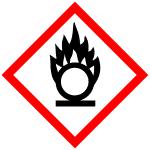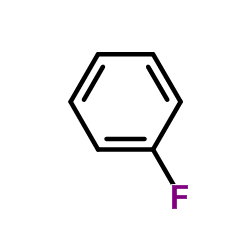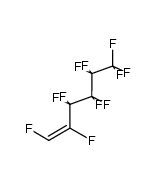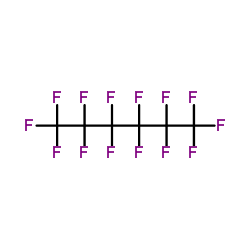13709-36-9
| 中文名 | 二氟代氙 |
|---|---|
| 英文名 | xenon difluoride |
| 英文别名 |
difluoroxenon
MFCD00040538 EINECS 237-251-2 Xenon difluoride |
| 密度 | 4.32 g/mL at 25 °C(lit.) |
|---|---|
| 熔点 | 129 °C(lit.) |
| 分子式 | F2Xe |
| 分子量 | 169.29000 |
| 闪点 | None |
| 精确质量 | 169.90100 |
| LogP | 0.45960 |
| 外观性状 | 白色结晶固体 |
| 蒸汽压 | 3.8 mm Hg ( 25 °C) |
| 储存条件 | 常温密闭,阴凉通风干燥惰性气体下 |
| 稳定性 | 常温常压下稳定 避免的物料 水分/潮湿 还原剂 空气 金属粉末。溶解度25g/1000g H2O(0℃),在水中慢慢水解为Xe,O2和HF。 |
| 分子结构 | 1、摩尔折射率:无可用的 2、摩尔体积(cm3/mol):无可用的 3、等张比容(90.2K):无可用的 4、表面张力(dyne/cm):无可用的 5、介电常数:无可用的 6、极化率(10-24cm3):无可用的 7、单一同位素质量:169.900961 Da 8、标称质量:170 Da 9、平均质量:169.2898 Da |
| 计算化学 | 1.疏水参数计算参考值(XlogP):无 2.氢键供体数量:0 3.氢键受体数量:2 4.可旋转化学键数量:0 5.互变异构体数量:无 6.拓扑分子极性表面积0 7.重原子数量:3 8.表面电荷:0 9.复杂度:2.8 10.同位素原子数量:0 11.确定原子立构中心数量:0 12.不确定原子立构中心数量:0 13.确定化学键立构中心数量:0 14.不确定化学键立构中心数量:0 15.共价键单元数量:1 |
| 更多 | 1. 性状:白色固体,四方晶系结晶,具有强氧化性。 2. 密度(g/mL,25/4℃):4.32 3. 相对蒸汽密度(g/mL,空气=1):未确定 4. 熔点(ºC):129.03 5. 沸点(ºC,常压):未确定 6. 沸点(ºC,5.2kPa):未确定 7. 折射率:未确定 8. 闪点(ºC):未确定 9. 比旋光度(º):未确定 10. 自燃点或引燃温度(ºC):未确定 11. 蒸气压(kPa,25ºC):5200 12. 饱和蒸气压(kPa,60ºC):未确定 13. 燃烧热(KJ/mol):未确定 14. 临界温度(ºC):未确定 15. 临界压力(KPa):未确定 16. 油水(辛醇/水)分配系数的对数值:未确定 17. 爆炸上限(%,V/V):未确定 18. 爆炸下限(%,V/V):未确定 19. 溶解性:未确定 |
Synonym: Section 2 - COMPOSITION, INFORMATION ON INGREDIENTS
Risk Phrases: 36/37/38 Section 3 - HAZARDS IDENTIFICATION EMERGENCY OVERVIEW
Irritating to eyes, respiratory system and skin.Hygroscopic. Potential Health Effects Eye: Dust may cause mechanical irritation. Skin: Dust may cause mechanical irritation. Effects of contact may be delayed. Ingestion: May cause digestive tract disturbances. Inhalation: May cause respiratory tract irritation. Effects of inhalation may be delayed. Chronic: No information found. Section 4 - FIRST AID MEASURES Eyes: Flush eyes with plenty of water for at least 15 minutes, occasionally lifting the upper and lower eyelids. Get medical aid immediately. Skin: Get medical aid. Flush skin with plenty of soap and water for at least 15 minutes while removing contaminated clothing and shoes. Wash clothing before reuse. Ingestion: If victim is conscious and alert, give 2-4 cupfuls of milk or water. Never give anything by mouth to an unconscious person. Get medical aid immediately. Inhalation: Remove from exposure to fresh air immediately. If not breathing, give artificial respiration. If breathing is difficult, give oxygen. Get medical aid. Notes to Physician: Treat symptomatically and supportively. Section 5 - FIRE FIGHTING MEASURES General Information: As in any fire, wear a self-contained breathing apparatus in pressure-demand, MSHA/NIOSH (approved or equivalent), and full protective gear. During a fire, irritating and highly toxic gases may be generated by thermal decomposition or combustion. Substance is noncombustible. Containers may explode when heated. Extinguishing Media: Do NOT use straight streams of water. For small fires, use dry chemical, carbon dioxide, or water spray. For large fires, use water spray, fog or regular foam. Cool containers with flooding quantities of water until well after fire is out. Section 6 - ACCIDENTAL RELEASE MEASURES General Information: Use proper personal protective equipment as indicated in Section 8. Spills/Leaks: Avoid runoff into storm sewers and ditches which lead to waterways. Wash area with soap and water. Clean up spills immediately, observing precautions in the Protective Equipment section. Sweep up or absorb material, then place into a suitable clean, dry, closed container for disposal. Avoid generating dusty conditions. Provide ventilation. Do not get water inside containers. Section 7 - HANDLING and STORAGE Handling: Wash thoroughly after handling. Use with adequate ventilation. Minimize dust generation and accumulation. Avoid contact with eyes, skin, and clothing. Keep container tightly closed. Avoid ingestion and inhalation. Storage: Store in a cool, dry, well-ventilated area away from incompatible substances. Keep containers tightly closed. Section 8 - EXPOSURE CONTROLS, PERSONAL PROTECTION Engineering Controls: Use adequate ventilation to keep airborne concentrations low. Personal Protective Equipment Eyes: Wear appropriate protective eyeglasses or chemical safety goggles as described by OSHA's eye and face protection regulations in 29 CFR 1910.133 or European Standard EN166. Skin: Wear appropriate protective gloves to prevent skin exposure. Clothing: Wear appropriate protective clothing to prevent skin exposure. Respirators: Follow the OSHA respirator regulations found in 29CFR 1910.134 or European Standard EN 149. Always use a NIOSH or European Standard EN 149 approved respirator when necessary. Section 9 - PHYSICAL AND CHEMICAL PROPERTIES Physical State: Powder Appearance: off-white Odor: odorless pH: Not available. Vapor Pressure: Not available. Viscosity: Not available. Boiling Point: Not available. Freezing/Melting Point: Not available. Autoignition Temperature: Not available. Flash Point: Not available. Explosion Limits, lower: Not available. Explosion Limits, upper: Not available. Decomposition Temperature: Solubility in water: insoluble Specific Gravity/Density: 5.9360g/cm3 Molecular Formula: F3La Molecular Weight: 195.91 Section 10 - STABILITY AND REACTIVITY Chemical Stability: Stable under normal temperatures and pressures. Conditions to Avoid: Incompatible materials, dust generation, moisture. Incompatibilities with Other Materials: Strong oxidizing agents, strong acids. Hazardous Decomposition Products: Irritating and toxic fumes and gases, hydrogen fluoride, fluorine. Hazardous Polymerization: Will not occur. Section 11 - TOXICOLOGICAL INFORMATION RTECS#: CAS# 13709-36-9: ZE1294166 LD50/LC50: CAS# 13709-36-9: Inhalation, mouse: LC50 = 445 mg/m3/2H; Oral, mouse: LD50 = 90 mg/kg. Carcinogenicity: Xenon difluoride - ACGIH: A4 - Not Classifiable as a Human Carcinogen (as F) (listed See actual entry in RTECS for complete information. Section 12 - ECOLOGICAL INFORMATION Section 13 - DISPOSAL CONSIDERATIONS Dispose of in a manner consistent with federal, state, and local regulations. Section 14 - TRANSPORT INFORMATION IATA No information available. IMO No information available. RID/ADR No information available. Section 15 - REGULATORY INFORMATION European/International Regulations European Labeling in Accordance with EC Directives Hazard Symbols: XI Risk Phrases: R 36/37/38 Irritating to eyes, respiratory system and skin. Safety Phrases: S 26 In case of contact with eyes, rinse immediately with plenty of water and seek medical advice. S 37/39 Wear suitable gloves and eye/face protection. WGK (Water Danger/Protection) CAS# 13709-36-9: No information available. United Kingdom Occupational Exposure Limits CAS# 13709-36-9: OES-United Kingdom, TWA (listed as ** undefined **): as F: 2.5 mg/m3 TWA Canada CAS# 13709-36-9 is listed on Canada's NDSL List. CAS# 13709-36-9 is not listed on Canada's Ingredient Disclosure List. Exposure Limits CAS# 13709-36-9 (listed as ** undefined **): OEL-AUSTRALIA:TWA 2.5 mg( F)/m3 OEL-BELGIUM:TWA 2.5 mg(F)/m3 OEL-CZECHOSLOVAKIA:TWA 1 mg(F)/m3;STEL 5 mg(F)/m3 OEL-DENMARK:TWA 2.5 mg(F)/m3 OEL-FINLAND:TWA 2.5 mg(F)/m3 OEL-FRANCE:TWA 2.5 mg(F)/m3 OEL-GERMANY:TWA 2.5 mg(F)/m3 OEL-HUNGARY:TWA 1 mg(F)/m3;STEL 2 mg(F)/m3 OEL-THE NETHERLANDS:TWA 2.5 mg(F)/m3 OEL-THE PHILIPPINES:TWA 2.5 mg(F)/m3 OEL-POLAND:TWA 1 mg(F)/m3 OEL-SWEDEN:TWA 2 mg(F)/m3 OEL-SWITZERLAND:TWA 1.8 ppm (1.5 mg(F)/m3);STEL 9.0 ppm OEL-THAILAND:TWA 2.5 mg(F)/m3 OEL-TURKEY:TWA 2.5 mg(F)/m3 OEL-UNITED KINGDOM:TWA 2.5 mg(F)/m3 US FEDERAL TSCA CAS# 13709-36-9 is listed on the TSCA inventory. SECTION 16 - ADDITIONAL INFORMATION N/A |
|
毒理学数据: 1、急性毒性:小鼠口经LD50:90 mg/kg; 主要的刺激性影响:在皮肤上面:在皮肤和粘膜上造成腐蚀性影响,刺激皮肤和粘膜; 在眼睛上面:强烈的腐蚀性影响,刺激的影响;没有已知的敏化影响; 2、吸入毒性:小鼠吸入LC50/2H:445mg/m3/2H。 生态学数据: 通常对水体是稍微有害的,不要将未稀释或大量产品接触地下水,水道或污水系统,未经政府许可勿将材料排入周围环境。
|
| 符号 |



GHS03, GHS05, GHS06 |
|---|---|
| 信号词 | Danger |
| 危害声明 | H272-H301-H314-H330 |
| 警示性声明 | Missing Phrase - N15.00950417-P210-P220-P280-P304 + P340 + P310-P305 + P351 + P338 |
| 个人防护装备 | Eyeshields;Faceshields;full-face particle respirator type N100 (US);Gloves;respirator cartridge type N100 (US);type P1 (EN143) respirator filter;type P3 (EN 143) respirator cartridges |
| 危害码 (欧洲) | O,T+,T |
| 风险声明 (欧洲) | R8:Contact with combustible material may cause fire. R25:Toxic if swallowed. R26:Very Toxic by inhalation. R34:Causes burns. |
| 安全声明 (欧洲) | S17-S26-S28-S36/37/39-S45 |
| 危险品运输编码 | UN 3087 5.1/PG 2 |
| WGK德国 | 3 |
| RTECS号 | ZE1294166 |
| 包装等级 | II |
| 危险类别 | 5.1 |
| 上游产品 8 | |
|---|---|
| 下游产品 10 | |





















